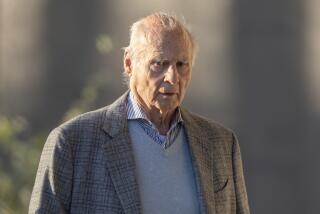Fastow’s Credibility Assailed on Stand
- Share via
HOUSTON — Defense lawyers in the Enron Corp. case completed their cross-examination Monday of star government witness Andrew S. Fastow, assailing his credibility on multiple fronts but without seeming to score a clean knockout punch.
In four days on the witness stand in federal court here, Fastow, Enron’s former chief financial officer, acknowledged repeatedly that he had secretly stolen millions of dollars from Enron, was driven by greed and had lied to private lawyers and federal investigators probing the energy-trading company’s collapse in late 2001.
He didn’t stop lying, Fastow testified Monday, until he signed a cooperation agreement with federal prosecutors in January 2004, pleading guilty to two conspiracy counts and agreeing to a 10-year prison sentence.
Fastow, 44, also corroborated testimony by previous witnesses incriminating former Enron Chairman Kenneth L. Lay and former Chief Executive Jeffrey K. Skilling in financial manipulations meant to boost reported profit and hide festering problems within the onetime Wall Street darling.
Jacob H. Zamansky, a New York securities lawyer who has visited Houston several times to witness the trial, said Fastow held up reasonably well on the stand.
“He was an important witness for the defense because they said in opening statements that they would destroy him, and I don’t think they accomplished that,” Zamansky said. “He was consistent with prior witnesses, and he opened a window for the jury by explaining things in simple terms.”
Lay, 63, and Skilling, 52, face decades in prison and millions of dollars in fines if convicted of the conspiracy and fraud charges against them.
Michael W. Ramsey, Lay’s chief defense lawyer, challenged Fastow’s testimony about a meeting between Fastow and Lay on Aug. 15, 2001, a day after Lay had resumed the chief executive’s post after Skilling’s surprise resignation.
Fastow said one of the things they discussed was Enron’s need for a “massive restructuring” to address severe weaknesses in two of its U.S. businesses and the decline to near worthlessness of some of the company’s overseas assets, including a power plant in India and a power company in Brazil.
Fastow testified that he approached Goldman, Sachs & Co. later that month to discuss work that the investment banking firm might do for Enron, including helping to organize the restructuring.
But Ramsey showed Fastow several Goldman Sachs documents relating to three meetings its representatives had held during that period with Fastow and other Enron officials. The documents indicated that most of the discussions concerned ways to protect Enron against a hostile takeover rather than on the purported need for a major restructuring.
Ramsey was trying to bolster the main theme of his defense, which is that Enron was healthy until only weeks before its December 2001 bankruptcy filing. Its demise, he contends, resulted from a loss of confidence by Enron’s trading partners, spurred in part by revelations of Fastow’s questionable deals. When the trading partners refused to extend Enron credit, trading -- Enron’s lifeblood -- ground to a halt and the firm could no longer pay its bills, Ramsey contends.
In a sidewalk news conference after Monday’s proceedings, Ramsey said he thought the defense had accomplished its purpose of undermining Fastow’s credibility.
Without a credible Fastow, he said, there is “not much center” to the government’s case.
Former Enron executive Sherron Watkins may take the stand as early as Wednesday, prosecutors said Monday. Watkins was the author of a much-publicized memo to Lay in August 2001 warning that if details surfaced publicly of questionable deals between Enron and off-the-books partnerships run by Fastow, Enron could collapse “in a wave of accounting scandals.”
More to Read
Inside the business of entertainment
The Wide Shot brings you news, analysis and insights on everything from streaming wars to production — and what it all means for the future.
You may occasionally receive promotional content from the Los Angeles Times.










